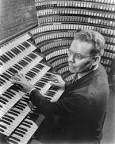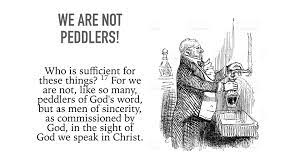Christ Lay in the Bonds of Death
Christ lag in Todesbanden
Audio
|
|||||||||||||||||
Christ lag in Todesbanden
Audio
|
|||||||||||||||||

Martin Luther, 1483–1546, portrait by Lucas Cranach the Elder, 1533
Luther’s hymn “Christ Jesus Lay in Death’s Strong Bands (Christ lag in Todesbanden)” is his reworking and expansion of the earlier “Christ Is Arisen (Christ ist erstanden),” which was one of his favorite hymns. It first appeared in the Erfurt Enchiridion of 1524. From there it worked its way into virtually all subsequent Lutheran hymnals.
The first page of “Christ lag in Todesbanden” as it originally appeared in the Erfurt Enchiridion, 1524.Luther’s original follows a rather more complex metrical form than the English version would suggest. The English is a straightforward 8.7. 8.7. 7.8. 7.4., whereas Luther’s German has seven syllables in each line leading up to the final Alleluia. That means that a slur is included in the first line of the A section that is not present in the English version, and for the meter to be maintained, the slur must move to a different syllable from stanza to stanza.
The translation, which is in the public domain, is that by Richard Massie, 1854, as altered for the Lutheran Service Book, 2006, No. 458, though some phrases have been restored from the Evangelical Lutheran Hymn-Book, 1927, No. 224, as better reflecting the German original.
Bach: Organ Concerto in A Minor by Vivaldi
Matthias Havinga plays J.S.Bach Fugue in A-minor BWV 543
Virgil Fox. Now Thank We All Our God | | Johann Sebastian Bach: Magnificat in D major, BWV 243 | Pachelbel Canon in D
James Cohen and the Boston Camarata -Jesus is the Light of the Way
“Awake, you who sleep,
Arise from the dead,
And Christ will give you light.”
(Ephesians 5:14)
Organ performance by Matthias Havinga
What I have noticed in my own life is the ease with which I can end up reading cheap literature, watching ho-hum television or listening to low-grade music. On the other hand, I am invariably inspired and edified when I choose to listen to someone like Johann Sebastian Bach. He wrote everything to the glory of God (Sole Deo Gloria)--and this can not be hidden.
I enjoy listening to the collected organ works of Bach played by the great French organist Marie Claire Alain. I was amazed this week to learn something new from her notes on BWV 552, the great Fugue in E flat major. Listen to this Fugue in mp3 format (http://ldolphin.org/audio/bwv552.mp3)
Ms. Alain says,
"Written for organo pleno, this marvel of religious architecture brings the collection to a close. Unsurprisingly, perhaps, the fugue comprises three sections devoted to the three Persons of the Trinity. The key-signature is E flat, i.e., three flats. And the time-signatures progress from compound time (2/4) to 6/4 and thence to 12/8. The main theme itself (B flat + G + C + B flat + E flat + D) represents Bach's signature. (In German notation, the opening notes of the theme are written B + G + C + B + ES + D = 2 + 7 + 3 + 2 + 18 + 4 = 41 = J. S. Bach).
The opening panel of the triptych, describing the majesty of God the Father, is 36 bars long: 3 + 6 = 9 = 3 x 3 = Exaltation of the Trinity. There are 12 entries of the subject A, representing the Twelve Apostles and hence the Church. In the second panel, which describes Christ's humanity, there are 21 entries of subject B (21 = the number of chorales in the collection, in addition to being a multiple of 3). Subject A is superimposed on it 6 times (6 = 3 x 2, symbolizing completion, as in the six days of the Creation). This second section comprises 45 bars (45 = 4 + 5 = 9).
The third panel describes the motivity of the Holy Ghost in a sacred dance. Like the opening section, it is 36 bars long. Subject C enters 21 times, while subject A enters 9 times. The main theme therefore appears 27 times in the course of the fugue, which is the same number as that of pieces contained in the collection as a whole.
It is an astonishing edifice, a prodigious achievement on the part of a composer familiar with subtlety of musical style, from counterpoint to numerology. But, more than that, it offers a fascinating glimpse of Bach in a moment of deep exultation. Often sad and racked by suffering, he stands here bathed in heavenly light as he turns his thoughts from meditation(Fugue I) to active endeavor (Fugue II) and, finally, to transcendent joy (Fugue III)." (The collection is by Erato Records)
For many years I have been hoping some Christian musician would undertake to teach the rest of us a class on the great hymns of the faith. The composer, the setting, the words and the music of many hymns are a great, inspiring part of the heritage of the church of Jesus Christ. In our day these great old hymns are all but forgotten. This is surely yet one more serious disconnect on our part, from the historical past of our Christian faith. The community we are actually connected to is not merely one generation deep, but has been under development for two millennia. God is not the God of the dead but of the living. We are connected to the saints of all the ages with whom we will soon be gathered. I hope we can live up to the standards many of our predecessors considered everyday holy Christian living.

One of my all-time favorite compositions is "Komm, süßer Tod, komm selge Ruh" (Come, sweet death, come, blessed rest)
On top of the 69 sacred pieces, each one featuring a melody and a figured bass, the hymnal known as the Schmelli Gesangbuch also includes almost 900 other hymns. But it's Bach's mournful music for solo voice and basso continuo, Komm, süßer Tod, komm selige Ruh, which steals the show.
Unlike many of the arrangements and newly harmonised chorales, this five-verse song is thought to have been written from scratch for the songbook. Bach used lyrics by an unknown poet, written around 1724, asking death to come quickly and peacefully to deliver the singer to heaven, where he can see the face of Jesus.
Komm, süßer Tod, first edition 1736
Komm, süßer Tod, komm selge Ruh
"Komm, süßer Tod, komm selge Ruh" (Come, sweet death, come, blessed rest) is a song for solo voice and basso continuo from the 69 Sacred Songs and Arias that Johann Sebastian Bach contributed to Musicalisches Gesangbuchby Georg Christian Schemelli (BWV 478), edited by Schemelli in 1736.
The text is by an anonymous author. Bach, by means of melody and harmony, expresses the desire for death and heaven. It is among his most popular works and has been adapted and transformed by several composers, such as Max Reger, Leopold Stokowski, Knut Nystedt, and for the Wanamaker Organ, by Virgil Fox.
( Wikipedia)

My all-time favorite performance is by Virgil Fox. Please listen!
Virgil Fox, Wanamaker Organ
Orchestral Version by Stokowski
Vilnius Bel Canto Chorus
Peter van de Velde, organ
Other favorites
Now Thank We All our God
Wachet Auf, Matthias Havinga, organ
Rachmaninov: The Isle of the Dead
"Come Sweet Rest" -- A Meditation
Old Time String Band - I Bid You Goodnight
James Alan Shelton - Song for Greta
Gigantic Legless Cauldrons - Sodium Chloride,
James Cohen and the Boston Camarata -Jesus is the Light of the Way
![]()
![]()

Lambert's Main Library
Email Lambert Dolphin
Archive for Newsletters
Your Questions and Comments are Invited
Library Annex (500+ new articles since 2018)
Help Thyself. No Charge

 January 20, 2023.
January 20, 2023.